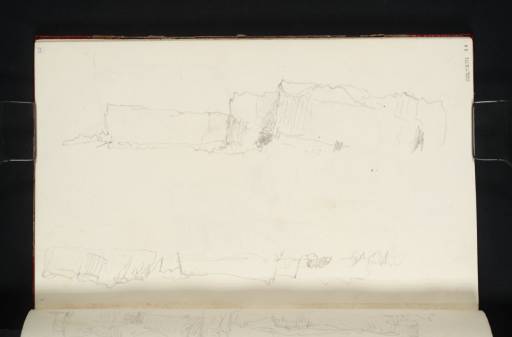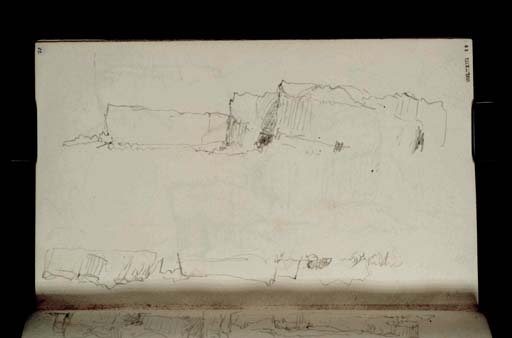J.M.W. Turner
>
1830-35 Annual tourist
>
Scotland 1831
>
Staffa Sketchbook
>
Artwork
Joseph Mallord William Turner Staffa with Fingal's Cave from the South; and the Island from the South-East 1831
Image 1 of 2
Joseph Mallord William Turner,
Staffa with Fingal's Cave from the South; and the Island from the South-East
1831
Joseph Mallord William Turner 1775–1851
Folio 20 Recto:
Staffa with Fingal’s Cave from the South; and the Island from the South-East 1831
D26780
Turner Bequest CCLXXIII 20
Turner Bequest CCLXXIII 20
Pencil on white wove paper, 116 x 186 mm
Inscribed in blue ink by John Ruskin ‘20’ top left running vertically
Stamped in black ‘CCLXXIII 20’ top right running vertically
Inscribed in blue ink by John Ruskin ‘20’ top left running vertically
Stamped in black ‘CCLXXIII 20’ top right running vertically
Accepted by the nation as part of the Turner Bequest 1856
References
1909
A.J. Finberg, A Complete Inventory of the Drawings of the Turner Bequest, London 1909, vol.II, p.876, CCLXXIII 20, as ‘Mountains.’.
1969
John Gage, Colour in Turner: Poetry and Truth, London 1969, pp.126, 253 note 247.
1975
Gerald Wilkinson, Turner’s Colour Sketches 1820–34, London 1975, p.69 reproduced as ‘Staffa’.
1972
Werner Haftmann, Andrew Wilton, Henning Bock and others, J.M.W. Turner: Gemälde Aquarelle, exhibition catalogue, Nationalgalerie Staatliche Museen Preußischer Kulturbesitz, Berlin 1972, p.113 under cat.17.
1974
Martin Butlin, Andrew Wilton and John Gage, Turner 1775–1851, exhibition catalogue, Royal Academy, London 1974, p.126 under cat.452.
1984
Martin Butlin and Evelyn Joll, The Paintings of J.M.W. Turner, revised ed., New Haven and London 1984, p.198 under cat.347.
There are two views of the island of Staffa on this page. Turner approached the island from the north, and steamed round the west before landing at the south (see folio 18 verso; D26777). The two sketches on this page were made as the boat was approaching the landing. The sketch at the top of the page (towards the fore-edge) is a view from the south, and was made before the sketch beneath, which is from the south-east. The mouth of Fingal’s Cave is roughly indicated at the right of the top sketch, and to the left of that near the water is the smaller Boat Cave. Turner has added vertical lines to the rock face to indicate the layer of basalt columns that are an interesting geological feature of the island. There is a similar sketch on folio 19 verso (D26779).
At the bottom of the page, drawn with the sketchbook inverted, is a view of the island from the south-east. At the left of the island is a dark triangle that represents Am Buachaille (or the Herdsman), a pyramidal rock made of diagonal basalt columns just to the south of the main island. This sketch and subsequent sketches on folios 20 verso–21 verso (D26781–D26783) show that Turner saw the island from the south-east before he landed at the southern point. David Wallace-Hadrill and Janet Carolan point out that ‘those who entered Fingal’s Cave by boat [...] landing on the rocks at its mouth would have done so from a small ship’s boat’,1 and Turner, in his letter to James Lenox, recalled that he ‘scrambled over the rocks on the lee side of the island.’2 The steamboat must therefore have sought the sheltered eastern side of the island from which to launch the dingy carrying visitors to Fingal’s Cave.
For references to all of Turner’s sketches of Staffa and Fingal’s Cave see folio 40 (D26817).
Thomas Ardill
March 2010
How to cite
Thomas Ardill, ‘Staffa with Fingal’s Cave from the South; and the Island from the South-East 1831 by Joseph Mallord William Turner’, catalogue entry, March 2010, in David Blayney Brown (ed.), J.M.W. Turner: Sketchbooks, Drawings and Watercolours, Tate Research Publication, December 2012, https://www


